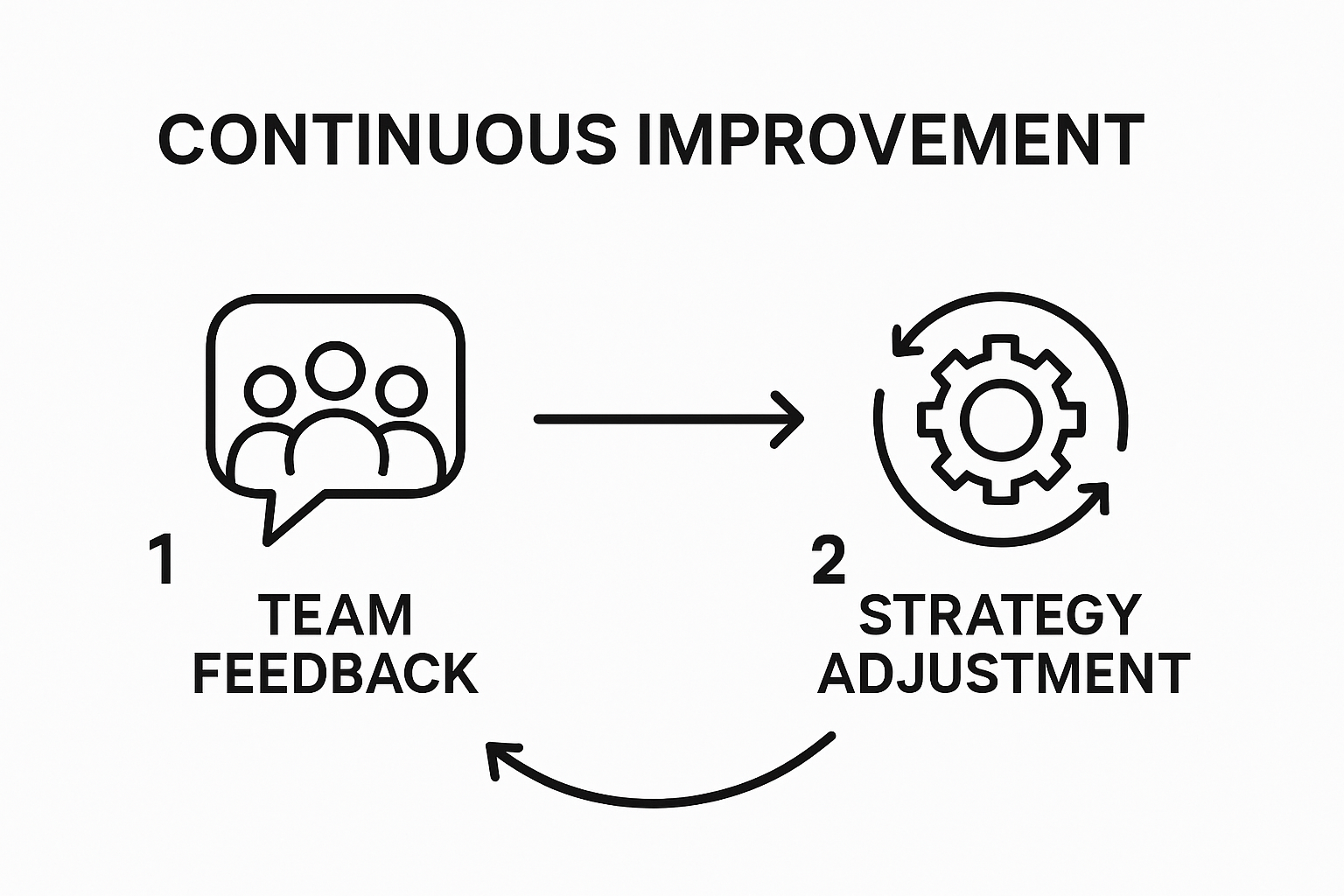Owner-Led AI Adoption Tips for Small Businesses

Small businesses feel the pressure to adopt new technologies at lightning speed. Yet almost half of small business tech projects stall or fail simply because owners rush in without a plan. Most folks think the hardest part of using AI is picking the right software. Actually, the real challenge is building a step-by-step strategy that fits your team and goals from the very start.
Table of Contents
- Step 1: Analyze Your Business Needs And Goals
- Step 2: Research Suitable AI Solutions For Your Industry
- Step 3: Develop A Structured Implementation Plan
- Step 4: Train Your Team On AI Tools And Systems
- Step 5: Monitor And Evaluate AI Performance
- Step 6: Adjust Strategies Based On Feedback And Results
Quick Summary
| Key Point | Explanation |
|---|---|
| 1. Define business goals for AI | Identify specific challenges and opportunities to align AI technology appropriately with your business needs. |
| 2. Research AI solutions specific to your industry | Utilize industry resources and peer insights to find suitable AI tools that address your operational needs. |
| 3. Develop a detailed implementation plan | Create a phased strategy with clear milestones and training periods to ensure smooth integration of AI solutions. |
| 4. Train team on new AI tools | Implement a comprehensive training approach that addresses various learning styles and builds confidence in using AI technology. |
| 5. Monitor and adjust based on feedback | Regularly evaluate AI performance and adapt strategies, ensuring continuous improvement and alignment with business objectives. |
Step 1: Analyze Your Business Needs and Goals
Successful AI adoption starts with a clear understanding of your specific business requirements. Many small business owners rush into technology implementations without first mapping out their precise objectives, which can lead to wasted resources and frustration. The goal of this initial step is to create a strategic roadmap that aligns AI technologies with your unique business challenges and opportunities.
Begin by conducting a comprehensive internal assessment of your current business operations. Walk through each core business function and identify repetitive tasks, bottlenecks, and areas experiencing inefficiencies. Look for processes that consume significant time or require manual data entry, customer communication, reporting, or administrative work. These are potential candidates for AI-powered automation and optimization.
According to research from the U.S. Government Accountability Office, defining clear business needs dramatically improves technology implementation success. Your assessment should answer critical questions: What specific problems are you trying to solve? Where can AI generate measurable value for your organization? Which departments or workflows would benefit most from intelligent automation?
To structure this analysis effectively, create a detailed document mapping out your findings. Document each potential AI application with specific metrics for improvement. For instance, if customer service response times are slow, quantify the current average response time and set a target reduction percentage. If inventory management feels clunky, calculate how much time employees currently spend on manual tracking and establish concrete goals for streamlining these processes.
Key verification criteria for completing this step include:
- A comprehensive document detailing current operational challenges
- Specific, measurable objectives for AI implementation
- Identified workflows most suitable for intelligent automation
- Estimated time and resource savings for each potential AI application
Remember that this initial analysis is not about finding the most advanced AI solution, but about understanding your business’s unique needs. Take your time, involve team members from different departments, and be honest about your current operational strengths and limitations. The more precise your initial assessment, the more effectively you can select and implement AI technologies that truly transform your business performance.
Below is a checklist table summarizing the key verification criteria for successfully completing each main step of the AI adoption process discussed in this article.
| Step | Verification Criteria | Evidence or Documentation |
|---|---|---|
| Step 1: Analyze Business Needs | Clear business objectives and mapped workflows | Document listing challenges, objectives, and workflow candidates |
| Step 2: Research AI Solutions | Comparison of multiple AI tools | Spreadsheet comparing features, costs, and integration notes |
| Step 3: Structured Implementation Plan | Defined phases, milestones, performance metrics | Written roadmap with timelines, training, and contingency plans |
| Step 4: Train Your Team | Team completes foundational and hands-on training | Training materials, attendance, and demonstration of skills |
| Step 5: Monitor Performance | Regular tracking and analysis of AI outcomes | Dashboard, review reports, and performance logs |
| Step 6: Adjust Strategies | Implementation of feedback and continuous improvement | Feedback forms, strategy adjustment reports, change tracking |
Step 2: Research Suitable AI Solutions for Your Industry
Navigating the complex landscape of AI solutions requires a strategic and methodical approach tailored to your specific business context. This step transforms your initial needs analysis into actionable research, helping you identify AI technologies that align precisely with your operational requirements.
Start by leveraging industry-specific resources and professional networks. Attend local business technology forums, join online communities focused on AI adoption in your sector, and connect with peers who have successfully implemented AI solutions. These connections provide invaluable insights into practical applications, potential challenges, and recommended tools that have proven effective in similar business environments.
According to research from the U.S. Small Business Administration, small businesses should prioritize free or low-cost AI tools during initial exploration. This approach allows you to test capabilities without significant financial risk. Investigate platforms offering trial versions or scaled-down implementations that match your business size and complexity.
Compile a comprehensive comparison matrix of potential AI solutions. For each tool, document key features, pricing structures, integration capabilities, and specific use cases relevant to your identified business needs. Pay close attention to user reviews from businesses similar to yours, focusing on real-world performance and potential limitations. Look beyond marketing materials and seek transparent assessments of each solution’s actual implementation challenges and benefits.
Key verification criteria for completing this step include:
- A detailed spreadsheet comparing at least 5 AI solutions in your industry
- Documentation of integration requirements for each potential tool
- Cost analysis comparing immediate investment against projected efficiency gains
- Notes from peer consultations and technology forum discussions
Remember that research is an iterative process. Do not feel pressured to select the most complex or expensive solution. The best AI technology is one that solves your specific business challenges while remaining manageable for your team’s technical capabilities. Prioritize solutions that offer robust customer support, clear implementation guidelines, and scalable features that can grow alongside your business.
Step 3: Develop a Structured Implementation Plan
Transforming your AI research into a concrete action plan requires careful strategic thinking and meticulous organization. A well-crafted implementation plan serves as your roadmap, transforming AI potential into practical business improvements. This step bridges the gap between theoretical exploration and actual technological integration.
Begin by creating a phased rollout strategy that breaks down your AI adoption into manageable stages. Start with a pilot project targeting the most straightforward and low-risk workflow you identified during your initial needs assessment. This approach allows your team to build confidence and technical understanding without overwhelming your organization. Determine specific milestones, expected outcomes, and measurable performance indicators for each phase of implementation.
According to research from Stanford Digital Economy Lab, structured workshops and guided planning are critical for successful AI integration. Develop a comprehensive document that outlines your implementation timeline, allocating realistic timeframes for each stage. Include dedicated periods for staff training, initial testing, performance evaluation, and potential adjustments.
Consider potential challenges and build flexibility into your plan. Identify potential resistance points within your team and develop strategies to address them proactively. This might involve additional training sessions, one-on-one consultations, or creating internal champions who can demonstrate the practical benefits of AI adoption. Your implementation plan should also include clear communication protocols, ensuring transparency about technological changes and their expected impacts.
Key verification criteria for completing this step include:
- A comprehensive implementation roadmap with defined stages
- Specific performance metrics for measuring AI tool effectiveness
- Identified training requirements for team members
- Contingency plans for potential implementation challenges
Remember that an implementation plan is a living document. Remain open to refinement and be prepared to adjust your approach based on initial results. The most successful AI adoptions are those that maintain flexibility, prioritize team engagement, and focus on solving real business challenges rather than implementing technology for its own sake.
Step 4: Train Your Team on AI Tools and Systems
Successful AI integration hinges on more than just technology selection. Empowering your team with the knowledge and confidence to effectively use new AI tools is crucial for transforming technological potential into real business value. This step focuses on creating a comprehensive training approach that reduces resistance and accelerates team adoption.
Design a multi-layered training strategy that acknowledges different learning styles and technical comfort levels within your team. Begin with foundational sessions that demystify AI technology, explaining core concepts in accessible language. These initial workshops should address common fears and misconceptions, presenting AI as a collaborative tool that enhances rather than replaces human capabilities. Create engaging presentations that showcase practical examples relevant to your specific business context, helping team members visualize how AI can simplify their daily workflows.
According to research from the Stanford Digital Economy Lab, targeted support and guided access to AI tools significantly improve SME technology adoption. Develop a training program that combines theoretical instruction with hands-on practical experience. Implement a mentorship model where more technically confident team members can support colleagues during the learning process. Consider creating short, digestible video tutorials, interactive online modules, and scheduled practice sessions that allow employees to experiment with AI tools in a low-pressure environment.
Recognize that learning is an ongoing process. Establish regular check-ins and continuous learning opportunities to support team members as they integrate AI into their workflows. Create a supportive feedback mechanism that allows employees to share challenges, ask questions, and suggest improvements. This approach not only accelerates skill development but also helps build a culture of technological curiosity and adaptability.
Key verification criteria for completing this step include:
- Documented training materials covering AI tool fundamentals
- Completion of initial training sessions by all team members
- Evidence of hands-on practice and skill development
- Established support system for ongoing learning and technical assistance
Remember that successful AI training is about building confidence, not just technical proficiency. Approach the process with patience, empathy, and a genuine commitment to supporting your team’s technological growth.
Step 5: Monitor and Evaluate AI Performance
Implementing AI solutions is not a one-time event but an ongoing process of continuous improvement. Developing a robust monitoring and evaluation framework allows you to transform initial AI implementations into strategic, high-performance business tools. This critical step ensures that your AI technologies deliver tangible value and adapt to your evolving business needs.
Establish a comprehensive performance tracking system that goes beyond surface-level metrics. Create a detailed dashboard that captures both quantitative and qualitative data about your AI tool’s performance. Quantitative metrics might include time saved, error reduction rates, and productivity improvements. Qualitative assessments should involve team feedback, identifying user experience challenges, and tracking how AI tools impact overall workflow efficiency.
According to research from the U.S. Census Bureau, small businesses are increasingly adopting AI technologies, making performance evaluation crucial. Schedule regular review sessions, ideally monthly or quarterly, where you thoroughly analyze your AI tools’ performance against the original implementation objectives.

During these sessions, compare actual results with your initial projections, looking for both successes and areas requiring adjustment.
Develop a systematic approach to identifying and addressing performance gaps. When discrepancies emerge, resist the temptation to immediately replace the technology. Instead, investigate the root causes. Are the issues related to tool capabilities, team training, or specific workflow integration challenges? Collect detailed documentation of any performance inconsistencies, including specific examples, frequency, and potential impact on business operations.
Key verification criteria for completing this step include:
- A comprehensive performance tracking dashboard
- Documented quarterly performance review reports
- Detailed logs of AI tool performance metrics
- Action plans for addressing identified performance challenges
Remember that effective AI monitoring is about maintaining a balance between critical assessment and supportive optimization. Approach performance evaluation as a collaborative process, engaging your team in identifying improvements and celebrating technological successes. Your goal is to create a dynamic, adaptive AI implementation that continues to evolve alongside your business needs.
Step 6: Adjust Strategies Based on Feedback and Results
Successful AI integration is not a destination but a continuous journey of adaptation and improvement. This final step transforms your initial implementation into a dynamic, responsive business strategy that evolves with your organizational needs and technological capabilities. Flexibility becomes your most valuable asset in navigating the complex landscape of AI implementation.
Create a structured feedback mechanism that captures insights from multiple perspectives. Engage team members at all levels, soliciting their experiences, challenges, and suggestions regarding AI tool performance. This approach goes beyond traditional top-down evaluation, recognizing that frontline employees often have the most nuanced understanding of how technology impacts daily workflows. Design anonymous survey tools, conduct regular team discussions, and establish an open communication channel that encourages honest, constructive feedback.
According to research from the Stanford Digital Economy Lab, successful AI adoption requires structured workshops and guided strategy development. Develop a systematic approach to reviewing and implementing feedback. Schedule quarterly strategy sessions where you comprehensively analyze performance data, team input, and business objectives. During these sessions, critically assess whether your current AI implementation aligns with your original goals and explore potential modifications or expansions.
Be prepared to make incremental adjustments rather than pursuing radical overhauls.

Sometimes, minor tweaks in workflow integration, additional team training, or slight reconfiguration of AI tool parameters can yield significant performance improvements. Maintain a documentation trail of all adjustments, tracking their specific impacts and learning from both successful modifications and less effective changes.
Key verification criteria for completing this step include:
- Documented feedback collection and analysis process
- Quarterly strategy adjustment reports
- Clear tracking of implemented changes and their outcomes
- Evidence of continuous learning and adaptation
Remember that AI strategy adjustment is an ongoing process of refinement. Approach each modification with curiosity, patience, and a commitment to continuous improvement. Your goal is to create an agile AI implementation that grows more intelligent and aligned with your business objectives with each iteration.
Ready to Drive Real AI Results for Your Business?
Are you feeling overwhelmed by endless choices and uncertainty about where AI fits best for your small business? This article outlines the challenges of aligning AI with real-world business needs, developing step-by-step plans, and ensuring your team feels confident rather than left behind. If you have ever worried about wasting resources on tools that do not deliver or about motivating your staff through new technology, you are not alone. Your domain expertise matters most—let the right AI approach make it work for you.

Take the first step toward customized, owner-led AI success with Average Robot. Our platform provides hands-on support, collaborative roadmaps, and automation strategies for every stage of your journey. Explore step-by-step guides, proven playbooks, and real-life support to turn AI complexity into a competitive advantage for your business. Do not wait for another quarter to pass while your competitors pull ahead. Visit Average Robot’s strategic consulting platform now to see how personalized solutions can boost your efficiency, morale, and business value today.
Frequently Asked Questions
What are the first steps to adopting AI as a small business owner?
Successful AI adoption begins with analyzing your business needs and goals. Conduct a comprehensive internal assessment of your operations to identify specific challenges and opportunities where AI can add value.
How can I ensure that my team effectively adopts new AI tools?
Empower your team through comprehensive training programs that include both foundational knowledge and hands-on practice. Encourage open feedback and create mentorship opportunities to build confidence among employees.
What type of AI solutions should small businesses consider?
Small businesses should prioritize free or low-cost AI tools that align with their specific industry needs. Research various solutions and focus on those that offer scalability, integration ease, and excellent customer support.
How do I measure the performance of AI tools in my business?
Establish a performance tracking dashboard that combines quantitative metrics, such as time savings and productivity improvements, with qualitative feedback from team members. Schedule regular review sessions to evaluate the effectiveness of your AI implementations.
Recommended
- 5 Costly Mistakes Businesses Make When Implementing AI…What Successful Business Owners Do Differently. — Average Robot
- AI and Leadership: What Owners Should Focus On — Average Robot
- About | Discover Opportunities - Schedule Today — Average Robot
- The Cost of Waiting: Why AI Adoption Delays Hurt SMBs — Average Robot
- Top Digital Marketing Trends for Small Businesses
- Understanding AI for Travel: Transforming Your Journeys - Yopki




